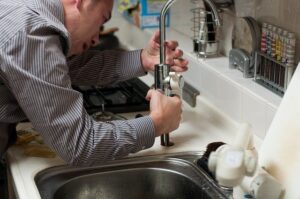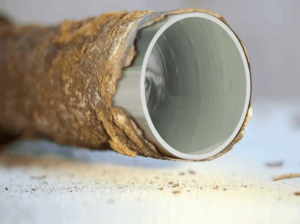Pipe Reviving: Embracing Trenchless Pipe Relining for Smart Solutions
Are you facing issues with your pipes?? Whether it’s persistent drain blockages, troublesome clogs, or pesky pipe leaks, your trusted plumber might have recommended the labour-intensive and costly option of excavating and replacing the pipes. The prospect of excavation, heavy machinery, and its associated expenses can be quite daunting. But before you proceed down that path, consider obtaining a second opinion from a plumbing company that specialises in pipe relining – a more efficient and cost-effective solution that can breathe new life into your pipes.
Plumbmaster Plumbing brings you the answer you’ve been seeking: Pipe relining!!
Our team possesses firsthand experience with the benefits of this ‘no-dig’ solution. Pipe relining involves creating a brand-new pipe within the existing one using a two-part epoxy that forms a durable fibreglass shell. It’s a quiet, speedy, and clean process, making it the ideal long-term solution for challenging and damaged pipes.
Within this article, we will explore the pros and cons of pipe relining, the working principles behind it, when it’s suitable, and the various types of pipe relining methods available.
Please note that while pipe relining is an excellent option, it may not always be the best fit for pipes with severe damage. Nevertheless, it’s a cost-effective solution that many homeowners remain unaware of, and it should be considered before more invasive methods.
Let’s explore how pipe relining works and what benefits it offers.
The Concept of Pipe Relining
What does it involve? Much like a caterpillar’s transformation into a butterfly, pipe relining undergoes a remarkable metamorphosis, revitalising old pipes by crafting a fresh inner lining with a two-part epoxy, ultimately creating a sturdy fibreglass shell within the existing pipe. This process rejuvenates your aging pipes without the need for disruptive digging or excavation, providing a long-lasting solution for troublesome and damaged pipes.
This innovative technology, known as trenchless pipe relining, is a ‘no-dig’ solution that is quiet, quick and leaves no mess behind. With pipe relining, you can bypass the chaos and upheaval associated with excavation, quickly returning to your daily routine.
How Our Experts Do it:
The process of pipe relining is both ingenious and efficient. Initially, our plumbing experts will inspect your pipes to assess the damage and identify blockages. Subsequently, high-pressure water jets are used to clean the pipes, removing any debris and preparing the surface for relining.
Next, we apply epoxy resin to a felt liner, which is inserted into the pipe and then expanded. The epoxy adheres to the interior of your pipes and hardens, creating a new pipe within the existing one. The end result is a fully restored and functional pipe that is guaranteed to last for up to 35 years.
Pipe relining offers you the benefits of a new, functional pipe without the hassles of excavation.
Ups and Downs of Pipe Relining
 When deciding on a pipe repair method, it’s crucial to weigh the advantages and disadvantages, just as we do at Plumbmaster Plumbing
When deciding on a pipe repair method, it’s crucial to weigh the advantages and disadvantages, just as we do at Plumbmaster Plumbing
On one hand, pipe relining provides a ‘no-dig’ solution that is faster, cost-effective, and guaranteed to last for decades. It’s also environmentally friendly, as it doesn’t involve disposing of materials, making it a convenient and eco-conscious choice.
However, it’s essential to acknowledge that pipe relining may not be possible in all cases, especially when pipes are severely damaged or crushed by tree roots. In such instances, excavation may remain the only option.
Nonetheless, for cases where pipe relining is a viable option, it stands out as a long-term solution that minimises disruption compared to other repair methods. This makes it a prudent choice for homeowners seeking to fix their pipes without wreaking havoc on their homes or gardens.
To summarise:
Pros of Pipe Relining:
- “No-dig” solution
- Faster repair process
- Cost-effective
- Guaranteed long-lasting results
- Environmentally friendly (no material disposal)
Cons of Pipe Relining:
- Not possible for severely damaged or root-crushed pipes
- Limited applicability in certain cases
- Invasive excavation may still be required in some instances
- Dependency on the condition of the pipes
- Potential disruption to landscaping and surroundings when not applicable
Diving Deeper on How It Works
The pipe relining process commences with a thorough inspection of the current pipeline. Once the inspection is complete, we insert a liner coated with a two-part epoxy resin into the pipe. The liner is then inflated, and the resin hardens to form a new pipe within the old one.
The newly created pipe is durable, with a life expectancy akin to installing a brand-new pipe. This process significantly reduces disruption compared to other repair options and is backed by a 35-year guarantee, providing a reliable and cost-effective solution for damaged pipes.
<span data-preserver-spaces="true">When to Use It</span>
When contemplating the repair of damaged pipes, consider pipe relining as a viable option. It’s a long-term solution that preserves the integrity of your home and garden, making it perfect for preventive measures.
Pipe relining is suitable for aging clay pipes in older homes, even if blockages haven’t occurred recently. It serves as an excellent preventative measure. Furthermore, it is a more practical choice than full pipe replacement when excavation costs are exorbitant and access to pipes is limited. Digging up hardscaped areas in your yard, such as paving and pathways, should be avoided whenever possible, as it can be intricate and cause further damage to the surrounding area.
With pipe relining, there’s no need for extensive excavation, and the process is quiet, rapid, and clean. It’s respectful of the environment, reducing its impact and making it an intelligent choice for those seeking a long-term and cost-effective solution.
So, if you’re considering pipe repair and want to ensure your pipes remain in optimal condition, contemplate pipe relining as a viable option.
Maximise Pipe Lifespan with Pipe Relining
Pipe relining is not just a method of fixing damaged pipes; it’s also a sustainable approach to ensuring your plumbing system’s longevity. By creating a new, durable inner lining within your existing pipes, pipe relining can extend the lifespan of your plumbing infrastructure, reducing the need for frequent replacements. This environmentally conscious choice minimises the disposal of old materials and reduces the overall carbon footprint associated with traditional pipe replacement methods.
Choose Plumbmaster Plumbing for Pipe Revival
Place your trust in Plumbmaster Plumbing to breathe new life into your pipes, ensuring they remain in top condition for years to come.
Don’t hesitate to get in touch with our expert team today to explore the benefits of trenchless pipe relining for your plumbing needs.
The Article Sydney Pipe Relining Or Trenchless Pipe Repairs First Appeared ON
: https://ad4sc.com











Comments are closed